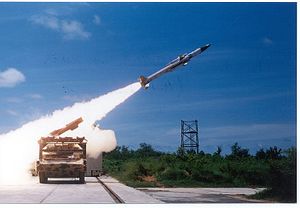Yesterday, the Indian Army inducted the Akash mid-range surface-to-air missile (SAM) system after a wait of 32 years, IBNLive reported.
The Akash (“Sky”) is an indigenously designed medium-range mobile surface-to-air missile defense system, whose surface-to-air supersonic missiles (armed with 60 kg high-explosive, pre-fragmented warheads) can engage aerial targets up to a distance of 25 km and at altitudes up to 18 km.
According to the developers (the Indian Defense Research and Development Organization, the Ordnance Factories Board, and Bharat Electronics), the new weapon is a multi-target, multi-directional, all weather air-defense system and can provide air defense missile coverage for an area of 2,000 square km.
The army version of the SAM system consists “of surveillance and tracking radars, control centers and ground support systems mounted on high mobility vehicles.” Each battery consists of four 3D passive electronically scanned array radars and four launchers with three missiles each.
One battery is capable of engaging up to 64 targets (a single radar can track up to 16 objects) and attack 12 different intruders simultaneously, including enemy fighters, helicopters, drones, and sub-sonic cruise missiles. The Akash supersonic missile can reach a top speed of up to Mach 2.5 and can be fired from both tracked and wheeled platforms, with command guidance throughout its entire flight.
According to army-technology.com:
The most important element of the Akash SAM system battery is its high-power, multi-function Rajendra phased-array radar.The 3D passive electronically scanned array Rajendra radar (PESA) can electronically scan and guide the missile towards targets. It provides information on the range, azimuth, and height of a flying target.
Interestingly, the Indian developers claim that the Akash’s solid-fuel technology makes it more accurate and economical to operate than the MIM-104 Patriot SAM system.
“If you fire two missiles in a ripple it produces a single shot k [kinetic] capability of 98 percent; we have a 3D central acquisition radar which looks far beyond, up to 120 kms. As the target comes near, we have the state of the art face tracking radar that tracks the target, and the systems which control the missile precisely,” Director General of Army Air Defense (DGAAD) Lt. General VK Saxena said. “Our regiment has six fire units, each fire unit has four Akaash launchers, each with three ready to fire missiles, so a lot of fire power goes along with each fire unit.”
The Indian Army will initially deploy two Akash regiments (approximately 2,000 missiles) with six batteries each over the next three years, whereas the Indian Air Force (IAF) has ordered eight Akash squadrons (1,000 missiles), two of which have already been inducted into the IAF and are deployed in airbases at Gwalior and Pune. The total cost of the acquisition will be close to $6 billion.

































